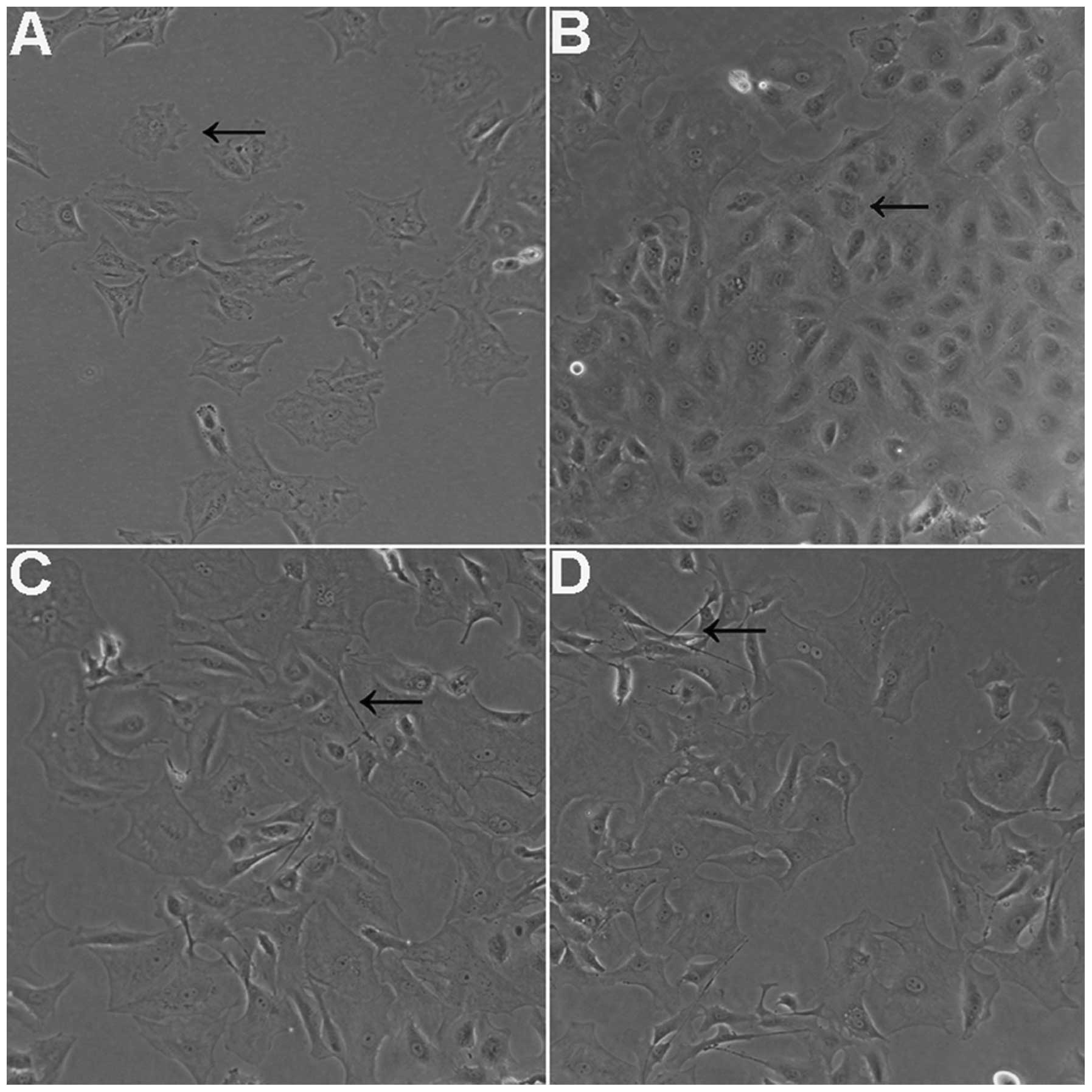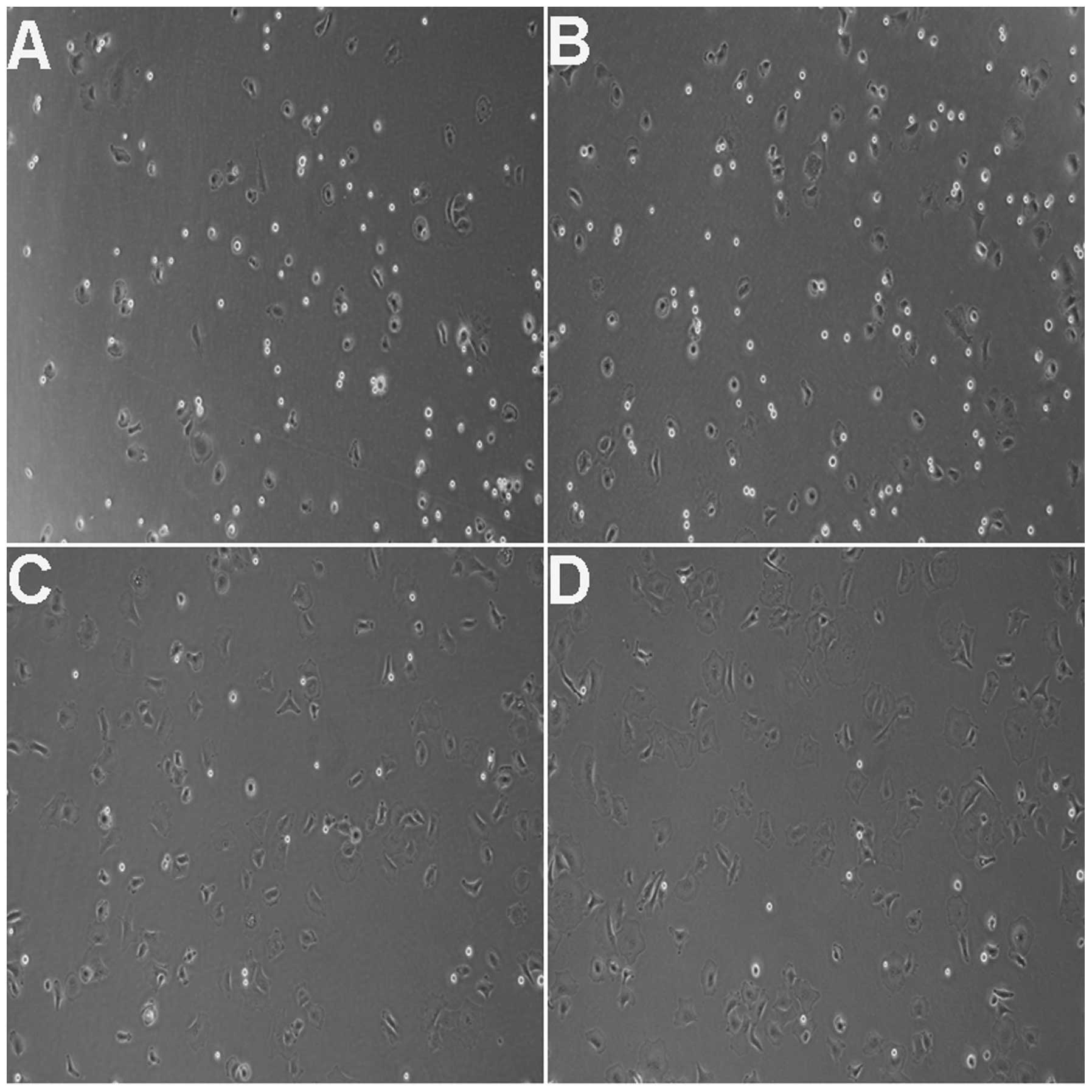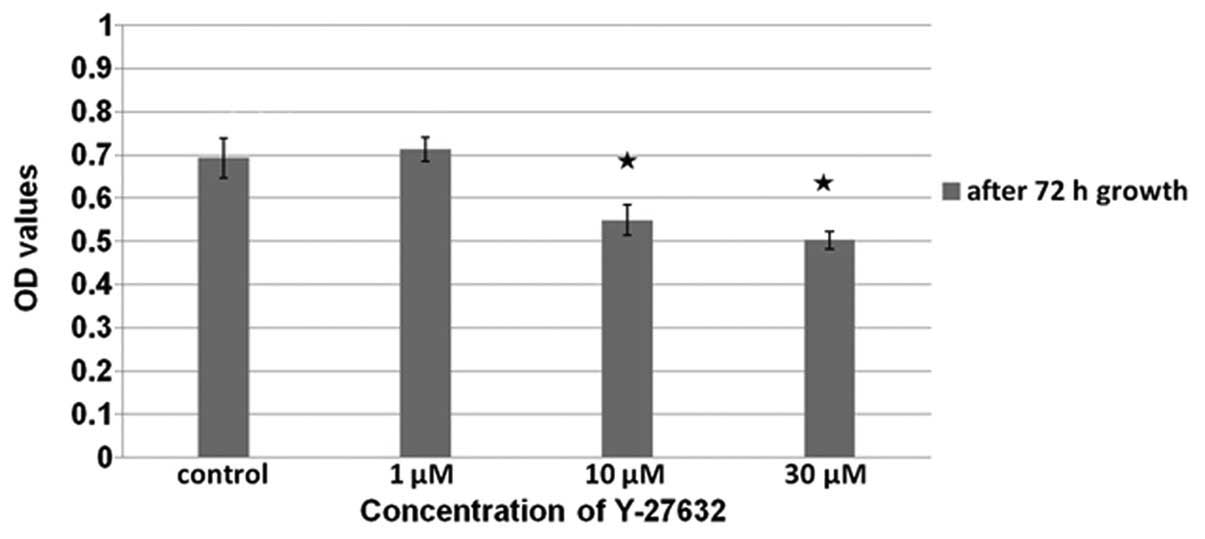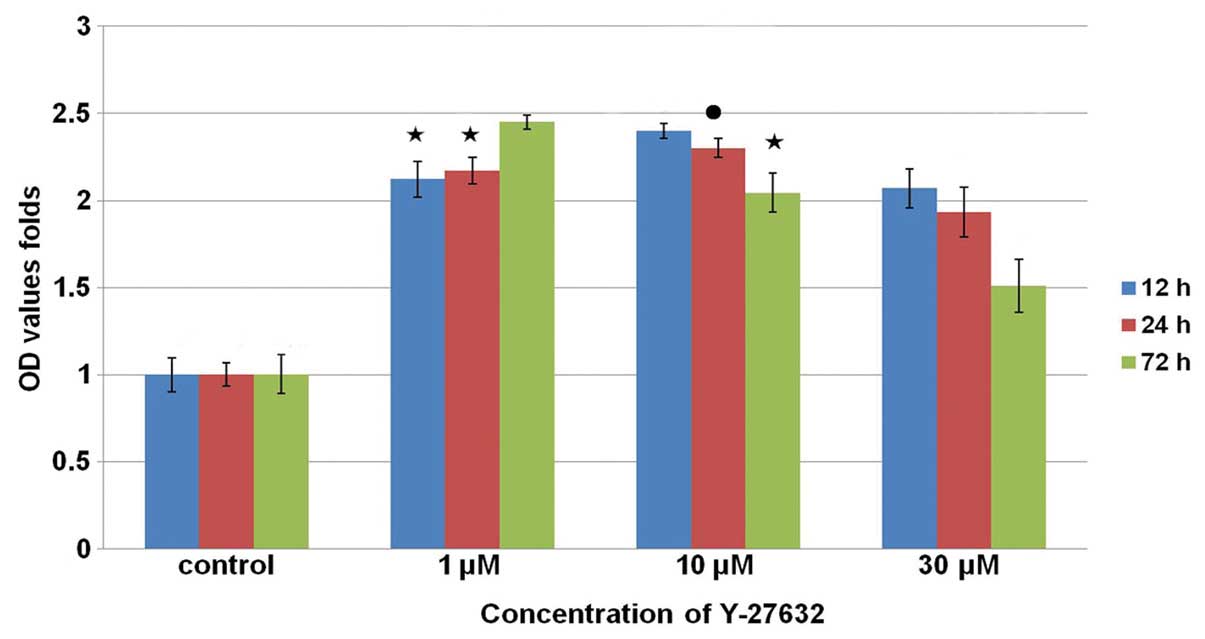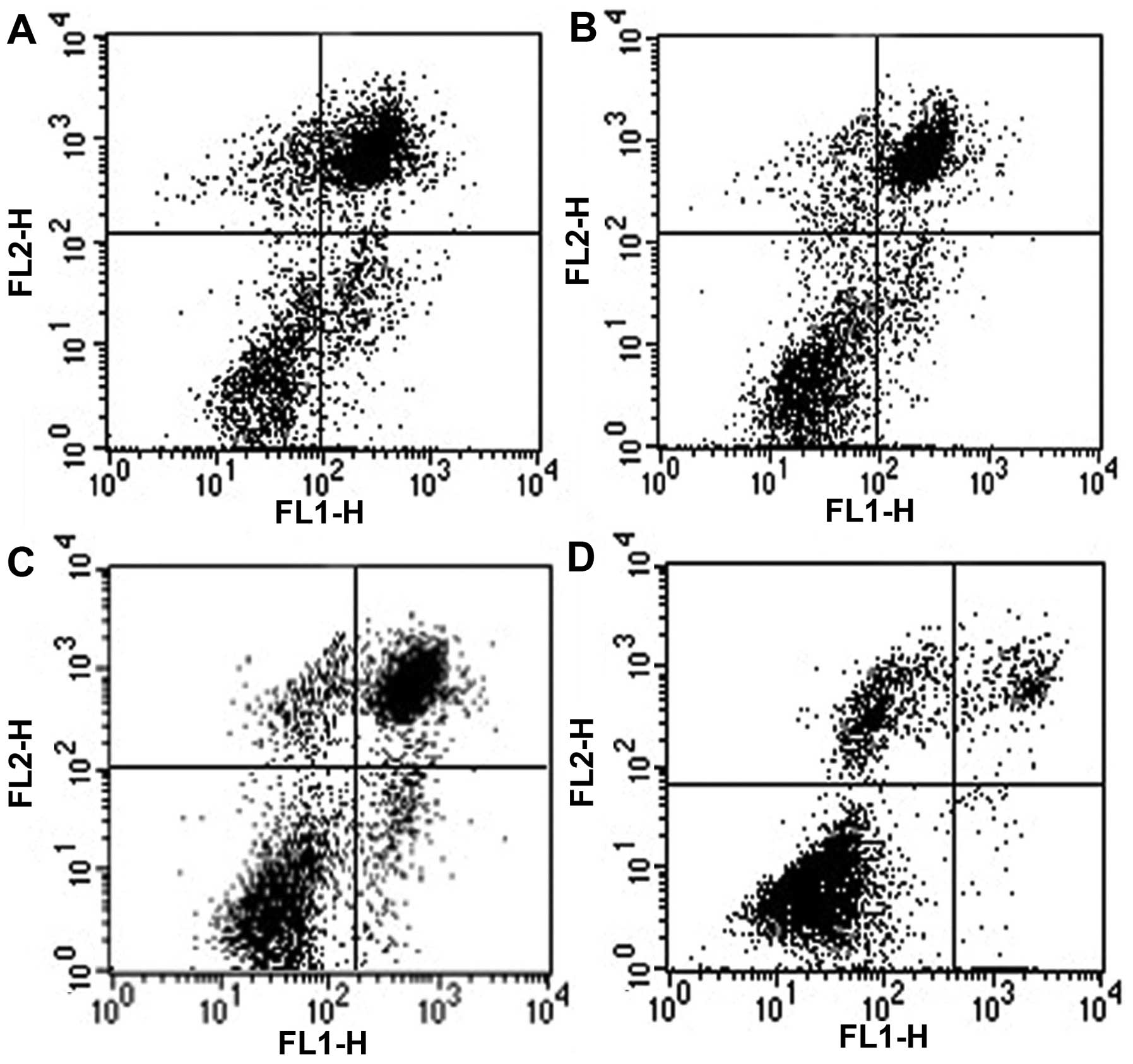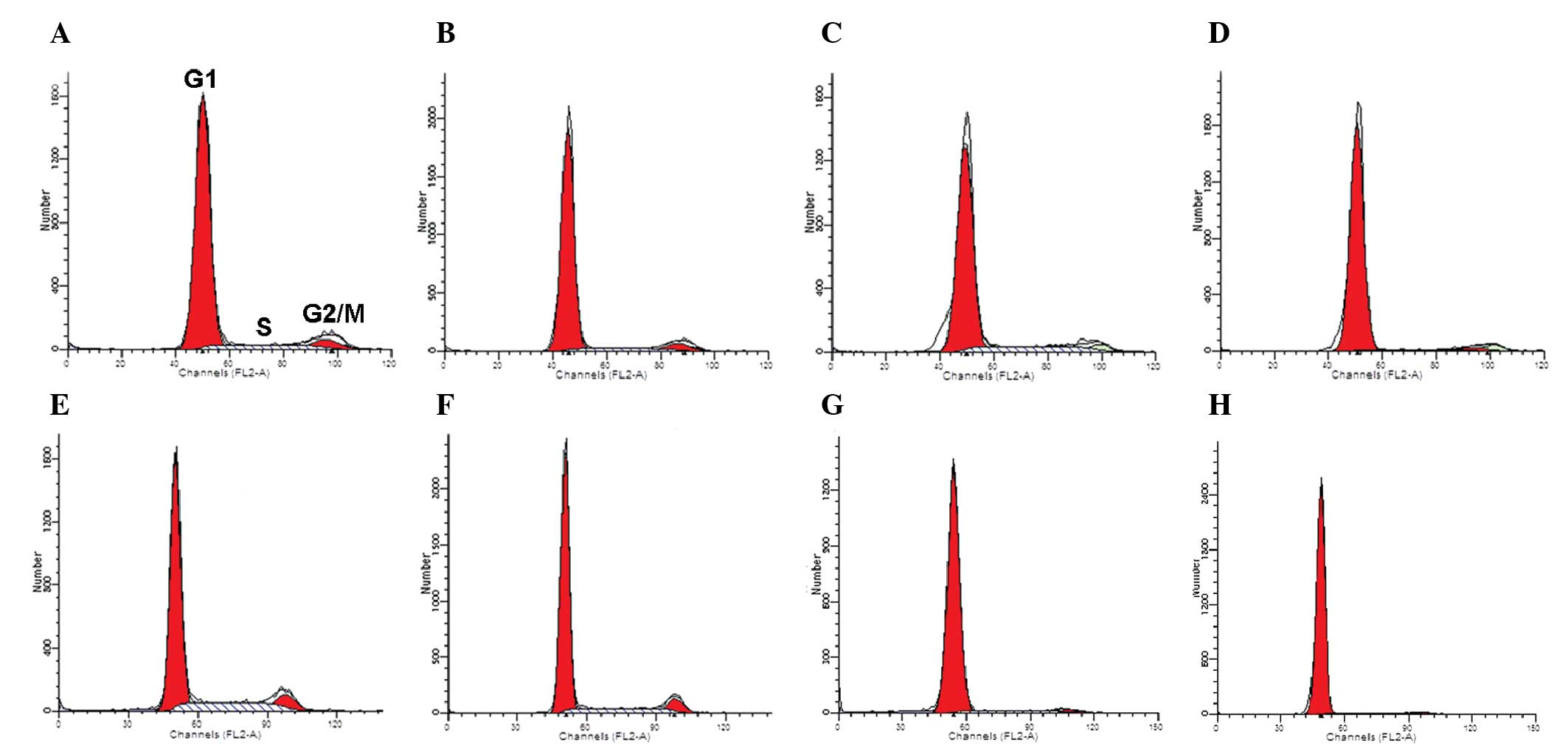Rho-associated protein kinase inhibitor, Y-27632, significantly enhances cell adhesion and induces a delay in G1 to S phase transition in rabbit corneal endothelial cells
- Authors:
- Published online on: April 16, 2015 https://doi.org/10.3892/mmr.2015.3628
- Pages: 1951-1956
Abstract
Introduction
Corneal endothelial cells (CECs) are crucial for the maintenance of corneal transparency. Human CECs (hCECs) are a non-proliferative monolayer of cells. This results in an average cell loss of 0.3–0.6% per year (1). The decrease may be accelerated as a result of accidental trauma; certain systemic diseases, such as diabetes (2); treatment for glaucoma (3); or endothelial dystrophies (4). When corneal endothelial cell density falls below a critical threshold, the functions of the endothelium are compromised, which leads to the formation of corneal edema and the loss of visual acuity (5).
In order to promote CEC proliferation, numerous mechanisms aiming to alter the non-proliferative status of these cells have been investigated. These include the release of cell-cell contact (6); growth factor-induced proliferation (7); the use of siRNA to reduce cyclin-dependent kinase inhibitors (8,9), SV40 large-T antigen (10); and induction of cell division by the human papilloma virus type 16 oncoproteins, E6/E7 (11). However, these results have not yet been transferred to clinical trials.
The Ras-related small GTPase, Rho, functions as a molecular switch of various cellular processes by shuttling between the inactive GDP-bound and active GTP-bound forms (12). Various cellular actions of Rho, include cell-to-substrate adhesion and motility, G1-S cell cycle progression and cell transformation, amongst other roles, by serum response factor (13). In addition, the microinjection of active RhoA into quiescent Swiss 3T3 fibroblasts (14) was found to induce the G1-S transition via downstream effectors, such as the Rho-associated coiled-coil forming protein serine/threonine kinase (ROCK) family of proteins. In particular, p160ROCK (ROCK-I) (15) and ROKa/Rho-kinase/ROCK-II (16–18). These studies verified that active RhoA induces G1-S transition.
In contrast to the findings from these studies, Y-27632, a specific inhibitor of the ROCK family of kinases (19), was used to promote cell cycle progression (20). However, these studies did not assess the cell cycle in detail; instead using changes in positive Ki67 and BrdU expression to measure cell cycle progression. Therefore, the present study was designed to further evaluate cell cycle G1-S phase progression and the effects of Y-27632 on rabbit CECs (rCECs).
Materials and methods
Animals
A total of 15 New Zealand white rabbits (Peking University Health Science Center, Beijing, China; weight, 1.5–2.0 kg) were used in the present study. The experiments performed were in accordance with the ARVO Statement for the Use of Animals in Ophthalmic and Vision Research and the Declaration of Helsinki. All animal care and experimental protocols complied with the Animal Management Rules of the Ministry of Health of the People’s Republic of China and the guide for the Care and Use of the Laboratory Animals of Peking University. All animal protocols were approved by the Animal Research Committee of the Peking University Health Science Center. All efforts were made to minimize animal suffering.
Primary culture
Descemet membranes were stripped to obtain CECs. The cells were then incubated in 0.25% trypsin (Sigma-Aldrich, St. Louis, MO, USA) at 37°C in 5% CO2. After 15 min, the CECs were resuspended in culture medium and plated in one well of a 12-well plate. All primary cell cultures and passages of CECs were performed in Dulbecco’s modified Eagle’s medium (DMEM; cat no. 31600-034, Invitrogen Life Technologies, Carlsbad, CA, USA) supplemented with 15% fetal bovine serum (FBS; cat no. 16000-044, Gibco-BRL, Carlsbad, CA, USA), 50 U/ml penicillin and 50 µg/ml gentamicin. CECs were maintained in a humidified atmosphere at 37°C in 5% CO2. Culture medium was changed every two days. When cells reached confluence, they were trypsinized and passaged at ratios ranging from 1:2 to 1:4. rCECs from passage three were used in the present study.
Effect of Y-27632 on cell shape
Passage three rCECs were plated in 24-well plates (1.1875×104 cells/well). Different concentrations of Y-27632 (1, 10 or 30 µM) were added simultaneously when plating or after culture for 72 h. Cells without Y-27632 treatment were used as the control. After 12, 24 and 72 h, changes in cell morphology were observed using an inverted microscope (Eclipse Ti; Nikon Corp., Tokyo, Japan).
Adhesion assay
The adhesion assay was performed as reported previously (21). Briefly, rCECs (1.1875×104) with Y-27632 (1, 10 and 30 µM) were plated in each well of 24-well plates. The cells without Y-27632 were used as controls. There were three wells, each at different concentrations. Following incubation at 37°C in 5% CO2 for 2 h, the 24-well plate was washed with phosphate-buffered saline (PBS) and confirmed that there were no residual non-adherent cells. Subsequently, the non-adherent cells of each well were removed into centrifuge tubes. The ratios of adherent cells were calculated using the following formula: adherent ratio = (1.1875×104 – number of unattached cells) / 1.1875×104
Cell counting kit-8 (CCK-8) assay to evaluate cell proliferation
Passage three rCECs were seeded in 96-well plates (2,000 cells/well) and the medium was changed daily. rCECs that were treated with Y-27632, received this compound either at plating or after 72 h of cell culture. For rCECs that received Y-27632 during plating, the cells were cultured with Y-27632 (1, 10 or 30 µM) for 12, 24 and 72 h. At these time points, the treatment medium was then replaced with fresh culture medium that did not contain Y-27632 and the treatment groups were cultured for a further 96 h. For rCECs that received Y-27632 following 72 h of cell growth, 1, 10 and 30 µM concentrations of Y-27632 were applied for 24 h. In order to assay the number of viable cells present, complete medium (100 µl) plus CCK-8 (10 µl) was added to each well. Untreated cells were used as controls and wells that did not contain cells were used as blank controls. After 2 h at 37°C, culture plates were agitated for 5 min prior to recording of optical density (OD) values at 450 nm. OD values for viable cells were calculated using the following formula: Fold difference in viable cell number = (ODsample−ODblank)/(ODcontrol−ODblank).
Analysis of cell cycle using flow cytometry
For rCECs treated with Y-27632 at the time of plating and those treated after 72 h of cell growth, cells were harvested and resuspended in 2.1 ml absolute ethyl alcohol and 0.9 ml PBS. Cells were then stained for 1 h in darkness with PBS containing 50 µg/ml propidium iodide (PI) and 100 µg/ml ribonuclease A [included in the Annexin-flurorescein isothiocyanate (FITC) apoptosis detection kit;cat no. APOAF-50TST; Sigma-Aldrich]. Cell cycle progression was then evaluated using flow cytometry (FACSCalibur; BD Biosciences, Franklin Lakes, NJ, USA). The results shown are representative of three independent experiments.
Apoptosis analysis
Using an Annexin-FITC apoptosis detection kit, cells were washed twice with Dulbecco’s PBS (Sigma-Aldrich) and resuspended in 1X binding buffer at a concentration of 1×106 cells/ml. For each sample, a 500 µl aliquot was combined with 5 µl Annexin V-FITC and 10 µl PI solution and incubated at room temperature in darkness for 10 min. The fluorescence for each sample was then detected and analyzed using flow cytometry (BD Biosciences).
Statistical analysis
Statistical analyses were performed using SPSS 16.0 statistical software (IBM, Armonk, N Y, USA). A completely randomized design analysis of variance (ANOVA; one-factor ANOVA) and independent samples t-test were used to evaluate test data. Experimental data are expressed as the mean ± standard deviation (SD). P<0.05 was considered to indicate a statistically significant difference.
Results
Effects of Y-27632 on cell shape
For cells treated with 1 µM (Fig. 1A) and 10 µM (Fig. 1B) Y-27632 at the time of plating, normal cellular morphology was observed at 24 h. However, for cells plated with 30 µM Y-27632 for 12 h, thin, long, neurite-like processes and cell extensions were observed (Fig. 1C). In addition, the cell shapes observed were not homogenous compared with the control group, or with cells treated with 1 and 10 µM Y-27632. At 24 h following removal of Y-27632, cells which had been treated with 30 µM Y-27632 remained irregular in shape, while the cells treated with 1 and 10 µM Y-27632 retained a generally normal shape. Furthermore, these changes were found to be concentration- and time-dependent (Fig. 1D). Parallel experiments with rCECs treated with Y-27632 following 72 h of cell growth were also performed and similar results were obtained.
Cell adhesion following Y-27632 treatment
Cell adhesion assays were performed and cell adhesion ratios were calculated 2 h after the cells were plated. A ratio of 84.21% (Fig. 2C and D) was recorded for rCECs treated with 10 and 30 µM Y-27632, while the ratios for control cells (19.33%; Fig. 2A) and the 1 µM treatment group (36.84%; Fig. 2B) were lower. Furthermore, the differences in adhesion ratios between the treatment groups and the control group, as well as between the 10 and 30 µM treatment groups and the 1 µM group, were statistically significant (P<0.01 in each case) (Table III).
Assessment of cell proliferation
Using a CCK-8 assay, the number of viable cells present was assayed (Figs. 3 and 4). For rCECs that were treated with Y-27632 following 72 h of cell growth, the number of viable cells present was determined at 24 h following treatment with Y-27632. In these cells, a dose-dependent decrease in viability was observed. In addition, of the control cells compared with the cells treated with 1 µM Y-27632 did not differ (P>0.05). However, the proliferation of the control cells was higher than that of the cells treated with 10 and 30 µM Y-27632 (P<0.01 in each case). Fig. 4 shows the results of the cell counting assays performed in parallel, with rCECs treated with Y-27632 at the time of plating. The number of viable cells was subsequently assayed at 12 and 24 h time points. The highest and lowest levels of proliferation were observed in the group that received treatment with 10 µM Y-27632 (P<0.01) and in the control cells (P<0.01), respectively. However, at the 72 h time point, the highest proliferation was observed for the rCECs treated with 1 µM Y-27632 (P<0.01). In addition, at each of the time points assayed, the proliferation levels of the cells treated with 30 µM Y-27632 were lower than those for cells that received 1 or 10 µM Y-27632. Proliferation was highest at the 72 h time point following treatment of rCECs with 1 μM Y-27632 (P<0.01). A difference in cell proliferation was also observed at the 12 and 24 h time points, although the difference was not significant (P>0.05). Furthermore, for cells receiving 10 or 30 µM Y-27632, a time-dependent decrease in proliferation was observed (P<0.01).
Apoptotic analysis
Levels of apoptosis were assayed following the treatment of rCECs with 10 µM Y-27632 (Table I and Fig. 5). Using Annexin V/PI staining, the percentage of cells undergoing apoptosis following treatment with Y-27632 during plating was 47.91±0.37% after 12 h. For rCECs treated with Y-27632 following 72 h of cell growth, the percentage of cells undergoing apoptosis at 24 h following the administration of Y-27632 was 8.48±0.98%. Cell apoptosis ratios were also lower for these two treatment groups compared with control cells, at 61.8±0.92 and 46.41±0.98%, respectively (P<0.01).
Cell cycle progression
The distribution of cells between various phases of the cell cycle was assayed using flow cytometry (Table II and Fig. 6). For rCECs treated with 10 µM Y-27632 during plating, a reduced number of cells transitioning from G1 phase to S/G2 phase was observed at 12 h and 72 h, compared with control cells examined at the same time points. In addition, the differences at the two time points were significant, and the percentage of cells in the G1 phase at 72 h was greater than the number of cells in the G1 phase at 12 h (P<0.01). For cells that were treated with Y-27632 following 72 h of cell growth, 10 µM Y-27632 induced the transition from S phase to G1 phase after 72 h (P<0.01).
Discussion
In the present study, treatment of rCECs with 10 µM Y-27632 maintained an improved cell shape and cell adhesion compared with treatment with 30 and 1 µM Y-27632. Previously, it has been demonstrated that CECs, in particular hCECs, require the promotion of their attachment for cell growth (22). For example, extracellular matrices (ECM) plated on coated culture surfaces, including collagen (23), ECM derived from bovine CECs (24), a mixture of laminin and chondroitin sulfate (25), and a commercially available FNC coating mix containing fibronectin, collagen and albumin (26), have been reported to promote cell adhesion. Although the underlying mechanisms responsible for enhanced cell adhesion have not been well-characterized, it has been hypothesized that the actin cytoskeleton has a critical role in combination with integrins (27–29). Vinculin, which was involved in the linkage of the integrin adhesion complex to the actin cytoskeleton, was upregulated in ROCK inhibitor-treated CECs. However, additional studies are required to further elucidate the mechanisms that mediate enhanced adhesion induced by ROCK inhibitors.
In the CCK-8 assays performed 24 h after the addition of Y-27632, it was initially observed that rCECs treated with 10 µM Y-27632 following 72 h of cell growth exhibited lower OD values than control cells. These results suggested that treatment with 10 µM Y-27632 did not promote rCEC proliferation; and instead either induced cell apoptosis or delayed cell cycle progression. This did not coincide with the results of a previous study (30), which reported that rCECs and monkey CECs treated with Y-27632 exhibited an increased number of proliferating cells. It was inferred that treatment different time points may produced different results. Therefore, the effects of Y-27632 added at the time of plating were then evaluated. These results demonstrated that OD value folds of Y-27632 (1, 10 and 30 µM) were markedly higher than that of the control groups. It appeared that Y-27632, when added at the same time as plating increased cell proliferation. However, due to the concomitant significant increase in cell adhesion, it was hypothesized that the increase in OD values was a result of the increased number of adherent cells.
In order to test this hypothesis, the effects of Y-27632 on cell cycle and apoptosis in rCECs were assessed using flow cytometry. As shown in the present study, with regard to cell shape, cell adhesion and the results of the CCK-8 assay, as well as the results from other studies (5,30–32), 10 µM Y-27632 was the optimal concentration for treatment of rCECs. Therefore, in the following study, 10 µM Y-27632 was used to investigate its effects on the cell cycle and apoptosis. In cells treated at the time of plating, at 12 and 72 h a delay in G1-S cell cycle progression was observed, and the percentage of G1-S transition at 72 h was lower than it was at 12 h. The effects of Y-27632 on the cell cycle appeared to occur in a time-dependent manner.
In cells treated following 72 h of cell growth, at 12 and 24 h, reduced G1-S phase cell cycle progression was also observed. This indicated that 10 µM Y-27632 did not promote G1-S cell cycle progression. Furthermore, the apoptosis assay revealed that 10 µM Y-27632 inhibited cell apoptosis. These results suggested that Y-27632 significantly promoted cell adhesion and inhibited cell apoptosis, and did not induce proliferation of rCECs. It was inferred that in previous studies, the apparent increase in rCECs proliferation may have been due to an increase of the numbers of attached cells, leading to an increase in the numbers of Ki67- and Brdu-positive cells. The results of the present study, corresponded with the results of previous studies, which demonstrated the effects of Y-27632 on hCECs (5), vascular smooth muscle cell (33), Swiss 3T3 cells (12) and myofibroblasts (34). A previous study reported that Y-27632 significantly inhibited thrombin-induced DNA synthesis in cultured aortic smooth muscle cells at 10 mM (33). This may explain why Y-27632 delayed cell cycle progression.
Notably, in the CCK-8 assay, it was shown that the OD value folds of cells treated with 1 µM Y-27632 increased with increasing time from the time of plating. However, in cells treated with 10 and 30 µM, the OD value folds decreased with increasing time from the time of plating. Furthermore, the OD value folds in cells treated with 1 µM at 72 h were higher than those in cells treated with 10 µM at 12 h (P<0.05) and 24 h (P<0.01). It was also observed that the OD values of cells treated with 1 µM Y-27632 following 72 h cell proliferation was increased in comparison with control. Therefore, 1 µM Y-27632 may be the optimal dose.
In 2008, Yin and Yu (35) reported that Y-27632 induced a reduction of CEC proliferation. The beneficial effects of Y-27632 on the eye remained to be elucidated. Therefore, the present results suggest that the use of Y-27632, either as a cell culture additive or in the form of eye drops, should be thoroughly investigated.
In conclusion, in the present study, Y-27632 significantly enhanced the adhesion of rCECs, inhibited cell apoptosis and delayed cell cycle progression. The mechanisms underlying the effect of Y-27632 on CECs and the other tissues of the eye remain to be elucidated and warrant further investigation prior to progression to clinical trials.
Acknowledgments
The present study was supported by the National Natural Science Foundation of China (grant no. 31271045).
References
|
Murphy C, Alvarado J, Juster R and Maglio M: Prenatal and postnatal cellularity of the human corneal endothelium. A quantitative histologic study. Invest Ophthalmol Vis Sci. 25:312–322. 1984.PubMed/NCBI | |
|
Schultz RO, Matsuda M, Yee RW, et al: Corneal endothelial changes in type I and type II diabetes mellitus. Am J Ophthalmol. 98:401–410. 1984. View Article : Google Scholar : PubMed/NCBI | |
|
Bigar F and Witmer R: Corneal endothelial changes in primary acute angle-closure glaucoma. Ophthalmol. 89:596–599. 1982. View Article : Google Scholar | |
|
Stainer GA, Akers PH, Binder PS and Zavala EY: Correlative microscopy and tissue culture of congenital hereditary endothelial dystrophy. Am J Ophthalmol. 93:456–465. 1982. View Article : Google Scholar : PubMed/NCBI | |
|
Pipparelli A, Arsenijevic Y, Thuret G, Gain P, Nicolas M and Majo F: ROCK inhibitor enhances adhesion and wound healing of human corneal endothelial cells. PloS One. 8:e620952013. View Article : Google Scholar : PubMed/NCBI | |
|
Gerdes J, Schwab U, Lemke H and Stein H: Production of a mouse monoclonal antibody reactive with a human nuclear antigen associated with cell proliferation. Int J Cancer. 31:13–20. 1983. View Article : Google Scholar : PubMed/NCBI | |
|
Haj FG, Markova B, Klaman LD, Bohmer FD and Neel BG: Regulation of receptor tyrosine kinase signaling by protein tyrosine phosphatase-1B. J Biol Chem. 278:739–744. 2003. View Article : Google Scholar | |
|
Kikuchi M, Zhu C, Senoo T, Obara Y and Joyce NC: p27kip1 siRNA induces proliferation in corneal endothelial cells from young but not older donors. Invest Ophthalmol Vis Sci. 47:4803–4809. 2006. View Article : Google Scholar : PubMed/NCBI | |
|
Joyce NC and Harris DL: Decreasing expression of the G1-phase inhibitors, p21Cip1 and p16INK4a, promotes division of corneal endothelial cells from older donors. Mol Vis. 16:897–906. 2010.PubMed/NCBI | |
|
Wilson SE, Lloyd SA, He YG and McCash CS: Extended life of human corneal endothelial cells transfected with the SV40 large T antigen. Invest Ophthalmol Vis Sci. 34:2112–2123. 1993.PubMed/NCBI | |
|
Wilson SE, Weng J, Blair S, He YG and Lloyd S: Expression of E6/E7 or SV40 large T antigen-coding oncogenes in human corneal endothelial cells indicates regulated high-proliferative capacity. Invest Ophthalmol Vis Sci. 36:32–40. 1995.PubMed/NCBI | |
|
Ishizaki T, Uehata M, Tamechika I, et al: Pharmacological properties of Y-27632, a specific inhibitor of Rho-associated kinases. Mol Pharmacol. 57:976–983. 2000.PubMed/NCBI | |
|
Narumiya S: The small GTPase Rho: cellular functions and signal transduction. J Biochem. 120:215–228. 1996. View Article : Google Scholar : PubMed/NCBI | |
|
Olson MF, Ashworth A and Hall A: An essential role for Rho, Rac and Cdc42 GTPases in cell cycle progression through G1. Science. 269:1270–1272. 1995. View Article : Google Scholar : PubMed/NCBI | |
|
Ishizaki T, Maekawa M, Fujisawa K, et al: The small GTP-binding protein Rho binds to and activates a 160 kDa Ser/Thr protein kinase homologous to myotonic dystrophy kinase. EMBO J. 15:1885–1893. 1996.PubMed/NCBI | |
|
Leung T, Manser E, Tan L and Lim L: A novel serine/threonine kinase binding the Ras-related RhoA GTPase which translocates the kinase to peripheral membranes. J Biol Chem. 270:29051–29054. 1995. View Article : Google Scholar : PubMed/NCBI | |
|
Matsui T, Amano M, Yamamoto T, et al: Rho-associated kinase, a novel serine/threonine kinase, as a putative target for small GTP binding protein Rho. EMBO J. 15:2208–2216. 1996.PubMed/NCBI | |
|
Nakagawa O, Fujisawa K, Ishizaki T, Saito Y, Nakao K and Narumiya S: ROCK-I and ROCK-II, two isoforms of Rho-associated coiled-coil forming protein serine/threonine kinase in mice. FEBS Lett. 392:189–193. 1996. View Article : Google Scholar : PubMed/NCBI | |
|
Uehata M, Ishizaki T, Satoh H, et al: Calcium sensitization of smooth muscle mediated by a Rho-associated protein kinase in hypertension. Nature. 389:990–994. 1997. View Article : Google Scholar : PubMed/NCBI | |
|
Okumura N, Koizumi N, Ueno M, et al: The new therapeutic concept of using a rho kinase inhibitor for the treatment of corneal endothelial dysfunction. Cornea. 30(Suppl 1): 54–59. 2011. View Article : Google Scholar | |
|
Bi YL, Zhou Q, Du F, Wu MF, Xu GT and Sui GQ: Regulation of functional corneal endothelial cells isolated from sphere colonies by Rho-associated protein kinase inhibitor. Exp Ther Med. 5:433–437. 2013.PubMed/NCBI | |
|
Peh GS, Beuerman RW, Colman A, Tan DT and Mehta JS: Human corneal endothelial cell expansion for corneal endothelium transplantation: an overview. Transplantation. 91:811–819. 2011. View Article : Google Scholar : PubMed/NCBI | |
|
Li W, Sabater AL, Chen YT, et al: A novel method of isolation, preservation and expansion of human corneal endothelial cells. Invest Ophthalmol Vis Sci. 48:614–620. 2007. View Article : Google Scholar : PubMed/NCBI | |
|
Blake DA, Yu H, Young DL and Caldwell DR: Matrix stimulates the proliferation of human corneal endothelial cells in culture. Invest Ophthalmol Vis Sci. 38:1119–1129. 1997.PubMed/NCBI | |
|
Engelmann K, Bohnke M and Friedl P: Isolation and long-term cultivation of human corneal endothelial cells. Invest Ophthalmol Vis Sci. 29:1656–1662. 1988.PubMed/NCBI | |
|
Zhu C and Joyce NC: Proliferative response of corneal endothelial cells from young and older donors. Invest Ophthalmol Vis Sci. 45:1743–1751. 2004. View Article : Google Scholar : PubMed/NCBI | |
|
Sastry SK and Burridge K: Focal adhesions: a nexus for intracellular signaling and cytoskeletal dynamics. Exp Cell Res. 261:25–36. 2000. View Article : Google Scholar : PubMed/NCBI | |
|
Worthylake RA, Lemoine S, Watson JM and Burridge K: RhoA is required for monocyte tail retraction during transendothelial migration. J Cell Biol. 154:147–160. 2001. View Article : Google Scholar : PubMed/NCBI | |
|
Worthylake RA and Burridge K: RhoA and ROCK promote migration by limiting membrane protrusions. J Biol Chem. 278:13578–13584. 2003. View Article : Google Scholar : PubMed/NCBI | |
|
Okumura N, Ueno M, Koizumi N, et al: Enhancement on primate corneal endothelial cell survival in vitro by a ROCK inhibitor. Invest Ophthalmol Vis Sci. 50:3680–3687. 2009. View Article : Google Scholar : PubMed/NCBI | |
|
Okumura N, Koizumi N, Ueno M, et al: ROCK Inhibitor converts corneal endothelial cells into a phenotype capable of regenerating in vivo endothelial tissue. Am J Pathol. 181:268–277. 2012. View Article : Google Scholar : PubMed/NCBI | |
|
Liu X, Ory V, Chapman S, et al: ROCK inhibitor and feeder cells induce the conditional reprogramming of epithelial cells. Am J Pathol. 180:599–607. 2012. View Article : Google Scholar : | |
|
Seasholtz TM, Majumdar M, Kaplan DD and Brown JH: Rho and Rho kinase mediate thrombin-stimulated vascular smooth muscle cell DNA synthesis and migration. Circ Res. 84:1186–1193. 1999. View Article : Google Scholar : PubMed/NCBI | |
|
Porter KE, Turner NA, O’Regan DJ, Balmforth AJ and Ball SG: Simvastatin reduces human atrial myofibroblast proliferation independently of cholesterol lowering via inhibition of RhoA. Cardiovasc Res. 61:745–755. 2004. View Article : Google Scholar : PubMed/NCBI | |
|
Yin J and Yu FS: Rho kinases regulate corneal epithelial wound healing. Am J Physiol Cell Physiol. 295:C378–C387. 2008. View Article : Google Scholar : PubMed/NCBI |



